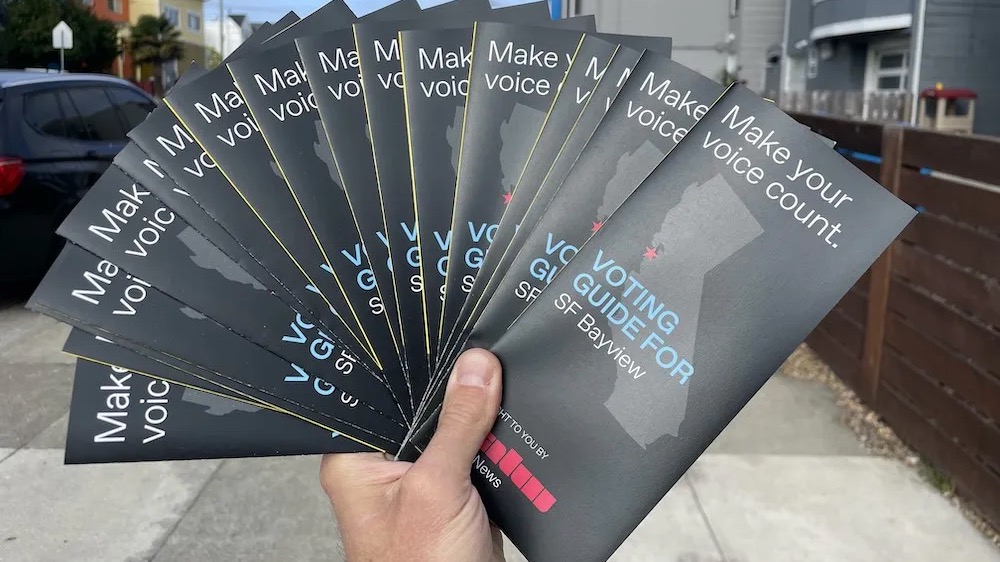Stations engage underrepresented communities with election resources

Ben Trefny / KALW
KALW's voter guides.
Public broadcasters have been preparing underserved communities for Tuesday’s elections with projects focused on where and how to vote, as well as topics they’ll find on the ballot.
Several stations received American Press Institute grants supporting new approaches to election coverage and improvements to existing projects that engage communities of color. In San Francisco, KALW used a $5,000 grant to expand its 2020 voter guides.
KALW Interim Executive Director Ben Trefny said the station created the guides for residents overwhelmed by statewide propositions and local ballot measures. The station studied Bay Area locations with low voter turnout. It chose to create voting guides for parts of Oakland, East Palo Alto, Richmond and San Francisco. Tailored to specific precincts, the guides explain where and when residents can vote.
This year, KALW is using its grant to produce physical guides and geographically targeted social media ads for digital versions of the guides. Volunteers and KALW employees have been handing out guides door to door, which has given Trefny the chance to talk with residents.
“We ended up having a lot of conversations with people who live in these communities about election issues and about what KALW could or should do to better serve them,” he said.
KALW is also reaching out to community organizations to expand their voting resources. Trefny said KALW plans to work with some of the same organizations as in 2020.
The communities with low voter turnout that KALW focused on are often overlooked or misrepresented, according to Trefny. He emphasized the importance of working with these communities beyond just election season.
“We really don’t want to kind of drop into communities and then drop out,” Trefny said. “I think that’s even potentially more problematic or harmful.”
Trefny expects KALW to be present in these communities for at least the next four months. Sonia Paul, the station’s election specialist, will continue to build relationships with community and nonprofit leaders. Trefny said Paul will also invite residents on air to discuss issues in their neighborhoods. Being present in the communities allows the station to build trust.
“We want to make sure that we are representing an institution of journalism, and especially being public-interest journalists, that we’re doing everything that we can to do our jobs well to serve these people who have not been treated the way that they should,” Trefny said.
‘Willing to fail’
Alaska Public Media also received a $5,000 API grant, which it used for listening sessions to inform voters about the state’s new ranked-choice voting system. Elections Engagement Editor Anne Hillman traveled to the remote communities of Kotzebue and Kodiak to host listening sessions.
Attendance at some of the sessions was sparse — only two people showed up in Kodiak. The station also hosted three listening sessions in Anchorage and two online. Participants engaged in simulations using Post-It notes to understand ranked-choice voting.
In addition, APM worked with Alaska Public Radio Network stations to provide election resources to Alaskan Native and Pacific Islander communities through public service announcements. It also targeted the communities through paid ads in local newspapers.
Reaching such audiences is difficult because building trust is a process, Hillman said. “I think just consistently being there and consistently showing up takes time, and so don’t think it’s a futile effort, by any means,” she said. “… But you have to be willing to fail a little and keep putting yourself out.”
Stations that received API grants participated in virtual events where they shared their projects with other organizations. Hillman said she looked for ideas to inspire other APM projects. She liked Carolina Public Press’ 10-question democracy quiz, which tested readers’ knowledge about democracy and voting in North Carolina.
Two other pubcasters also received API grants. WBUR in Boston created a Massachusetts election guide in the form of a WordPress add-on. And Connecticut Public Broadcasting developed a toolkit for watching and listening parties centered on debates that it broadcast.
In L.A., explaining ballot propositions
In Los Angeles, PBS SoCal/KCET drew on existing funds to continue its Ballot Brief resource for the fifth election cycle. The Ballot Brief is a one-stop shop for voting resources such as videos, candidate guides, polling information and election news.
This year, the station partnered with The Civics Center, a nonprofit that builds voter participation among high-school students. The organizations staged a “California Prop Party,” an online event for high-school voters. The event explored California’s ballot proposition system and took a deeper dive into propositions on the ballot this year.
The Oct. 19 event featured the station’s “Props in a Minute,” a series of one-minute videos in English and Spanish. Videos simplified ballot propositions with engaging graphics breaking down what “yes” and “no” votes mean.
KCET is also using the engagement platform Hearken to gather feedback from viewers. It will use feedback on viewers’ information needs in coming election cycles as it continues offering Ballot Brief resources.
The station may provide election resources in additional languages in the future, according to Justin Cram, senior director of digital content for the station’s parent organization, the Public Media Group of Southern California. Those languages could include Vietnamese and Mandarin Chinese.
“It’s really important for people to see themselves in the content,” Cram said.





